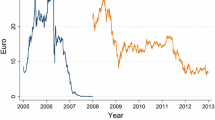Abstract
This study develops an analytical model of emissions markets equipped with a safety valve mechanism. It examines how a regulator can control emission reductions by emitters by setting two policy parameters: emission targets and trigger prices. I demonstrate that the capabilities of these two policy parameters are greatly affected by uncertainty regarding unconstrained aggregate emissions. I also show that there exists a specific combination of target and trigger-price settings that eliminates the need to consider uncertainty regarding unconstrained aggregate emissions when regulators set emission reduction goals. The model and its findings identify a rule for setting trigger prices with respect to the total design of tradable permit systems and thus offer practical guidance in designing a permit market.
Similar content being viewed by others
References
Adar Z., Griffin J. M. (1976) Uncertainty of the choice of pollution control instruments. Journal of Environmental Economics and Management 3: 178–188
Baumol W. J., Oates W. E. (1988) The theory of environmental policy (2nd ed.). Cambridge University Press, Cambridge
Ben-David S., Brookshire D., Burness S., McKee M., Schmidt C. (2000) Attitudes toward risk and compliance in emission permit markets. Land Economics 76(4): 590–600
Buchanan J. M., Tullock G. (1975) Polluters’ profits and political response: Direct controls versus taxes. American Economic Review 65(1): 139–147
Cropper M. L., Oates W. E. (1992) Environmental economics: A survey. Journal of Economic Literature 30: 675–740
Ellerman A. D., Joskow P. L., Schmalensee R., Montero J.-P., Bailey E. (2000) Markets for clean air: The U.S. acid rain program. Cambridge University Press, Cambridge
Finkelshtain I., Kislev Y. (1997) Prices versus quantities: The political perspective. Journal of Political Economy 105(1): 83–100
Fishelson G. (1976) Emission control policies under uncertainty. Journal of Environmental Economics and Management 3: 189–197
Hahn R. W. (1984) Market power and transferable property rights. Quarterly Journal of Economics 99(4): 753–765
Jacoby H. D., Ellerman A. D. (2004) The safety valve and climate policy. Energy Policy 32(4): 481–491
Joskow P. L., Schmalensee R., Bailey E. M. (1998) The market for sulfur dioxide emissions. The American Economic Review 88(4): 669–685
Kijima M., Maeda A., Nishide K. (2010) Equilibrium pricing of contingent claims in tradable permit markets. Journal of Futures Markets 30(6): 559–589
Klaassen G. (1996) Acid rain and environmental degradation: The economics of emission trading. International Institute for Applied Systems Analysis, Edward Elgar, Cheltenham, UK
Krishna K., Tan L. H. (1999) Transferable licenses versus nontransferable licenses: What is the difference?. International Economic Review 40(3): 785–801
Laffont J.-J. (1977) More on price vs. quantities. Review of Economic Studies 44(1): 177–182
Maeda A. (2003) The emergence of market power in emission rights markets: The role of initial permit distribution. Journal of Regulatory Economics 24(3): 293–314
Maeda A. (2004) Impact of banking and forward contracts on tradable permit markets. Environmental Economics and Policy Studies 6(2): 81–102
Malik A. S. (1990) Markets for pollution control when firms are noncompliant. Journal of Environmental Economics and Management 18: 97–106
Montero J.-P. (1997) Marketable pollution permits with uncertainty and transaction costs. Resource and Energy Economics 20: 27–50
Montero J.-P. (2000) Optimal design of a phase-in emissions trading program. Journal of Public Economics 75: 273–291
Montero J.-P. (2002) Prices versus quantities with incomplete enforcement. Journal of Public Economics 85: 435–454
Montgomery D. W. (1972) Markets in licenses and efficient pollution control programs. Journal of Economic Theory 5: 395–418
Pizer W. A. (1999) The optimal choice of climate change policy in the presence of uncertainty. Resource and Energy Economics 21: 255–287
Pizer W. A. (2002) Combining price and quantity controls to mitigate global climate change. Journal of Public Economics 85(3): 409–434
Roberts M. J., Spence M. (1976) Effluent charges and license under uncertainty. Journal of Public Economics 5: 193–208
Stavins R. N. (1996) Correlated uncertainty and policy instrument choice. Journal of Environmental Economics and Management 30: 218–232
Stranlund J. K., Chavez C. A. (2000) Effective enforcement of a transferable emissions permit system with a self-reporting requirement. Journal of Regulatory Economics 18(2): 113–131
Stranlund J. K., Dhanda K. K. (1999) Endogenous monitoring and enforcement of a transferable emissions permit system. Journal of Environmental Economics and Management 38: 267–282
Tietenberg T. H. (2006) Emissions trading: Principles and practice (2nd ed.). Resources for the future, Washington, DC
Tisato P. (1994) Pollution standards vs. charges under uncertainty. Environmental and Resource Economics 4: 295–304
Yohe G. W. (1976) Substitution and the control of pollution: A comparison of effluent charges and quantity standards under uncertainty. Journal of Environmental Economics and Management 3: 312–324
Yohe G. W. (1977) Comparisons of price and quantity controls: A survey. Journal of Comparative Economics 1: 213–233
Yohe G. W. (1978) Towards a general comparison of price controls and quantity controls under uncertainty. Review of Economic Studies 45(2): 229–238
Watson W. D., Ridker R. G. (1984) Losses from effluent taxes and quotas under uncertainty. Journal of Environmental Economics and Management 11: 310–326
Weitzman M. L. (1974) Prices vs. quantities. Review of Economic Studies 41(4): 477–491
Author information
Authors and Affiliations
Corresponding author
Rights and permissions
About this article
Cite this article
Maeda, A. Setting trigger price in emissions permit markets equipped with a safety valve mechanism. J Regul Econ 41, 358–379 (2012). https://doi.org/10.1007/s11149-011-9168-x
Received:
Accepted:
Published:
Issue Date:
DOI: https://doi.org/10.1007/s11149-011-9168-x




